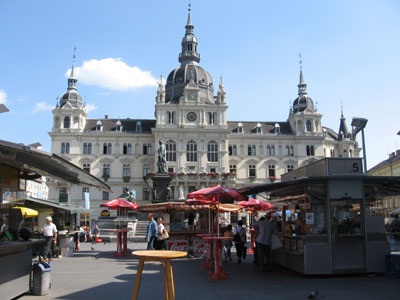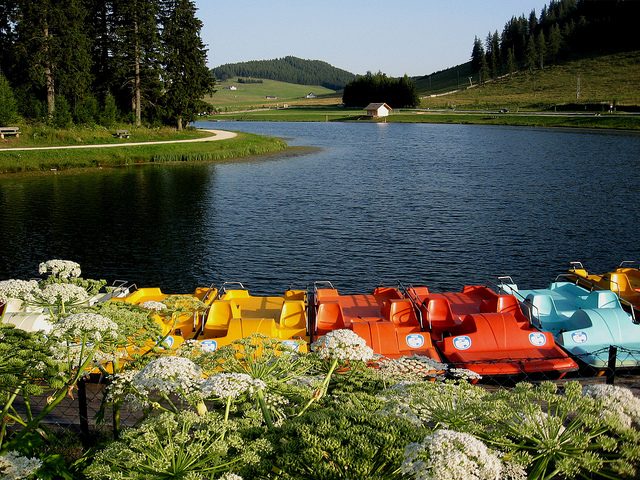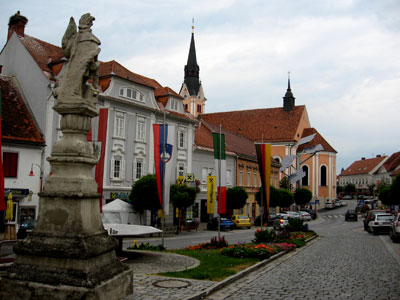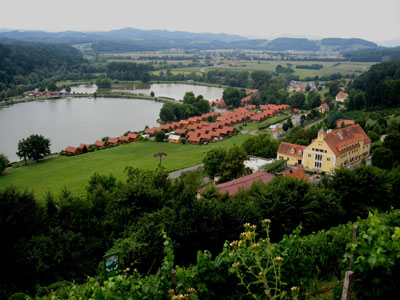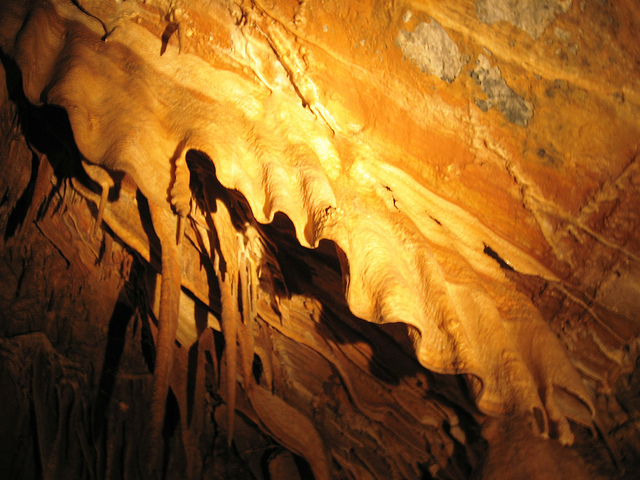But what a shame! Graz is an absolutely gorgeous destination: it is a designated UNESCO World Heritage Site because it has one of the most well-preserved late medieval and Renaissance city centres in Europe. It was also designated as the European Cultural Capital in 2003. Graz is known for outstanding architecture, music and various leading edge arts festivals throughout the seasons.

The imposing baroque pilgrimage church of Mariatrost
On my way to Graz I made my first stop in Mariatrost to visit the impressive baroque pilgrimage church on the hill. I then stopped my car near the Opera House and walked down the Herrengasse, Graz’ popular shopping promenade and part of the extensive pedestrian area. I admired the Renaissance courtyard of the Landhaus, seat of the Provincial Styrian Government, and made my way to the Hauptplatz, the city’s main square. It is a beautiful public space, anchored by an impressive late 19th century city hall that overlooks stately houses flanking the square.

The City Hall of Graz
The view from the Hauptplatz is framed by the Schlossberg, a rock that is located in the middle of the city that once featured an imposing medieval fortress. Most of the fortifications were destroyed by Napoleon’s troops in 1809, but the citizenry of Graz paid significant ransom money to retain its most beloved landmark: the Uhrturm (“Clock Tower”), the tower with the four oversized clock faces whose hour hand is longer than its minute hand.

Graz’ most famous landmark: the “Uhrturm” – it’s 2:20 pm
This clock tower has for centuries been the symbol of Graz and I enjoyed my view over the city from its terraces after my funicular ride up the mountain. I also took in the afternoon performance of the carillon on the Glockenspielplatz, where since 1905 the music of 24 bells accompanies the mechanical dance of a couple made from wood, entertaining dozens of tourists who congregate to watch.

Habsburg emperor’s mausoleum in Graz
My brother and sister-in-law had taken the next day off and we were planning an excursion further afield: our destination was a mountain peak called Mangart in Slovenia, located about a three-hour drive from my home town. The beauty of Central Europe is its diversity of landscapes and its small distances, and in just a few hours of driving through the Austrian province of Carinthia we arrived in Val Canale, an area where Austria, Italy and Slovenia meet. Incidentally this is also the only area where the Germanic, Romance and Slavic language families come together right next to one another. We passed by the picturesque Predil Lake and continued our climb into the high mountains and crossed the Italian border into Slovenia.

The picturesque Predil Lake in Italy
But as it can be with the best laid plans of mice and men, our hiking trip to the Mangart Mountain was not to be: our car overheated and there was no way we were going to make it any further. We had to stop, let the car cool down and turn around to go back down the mountain. Fortunately, our disappointment did not last long since we came up with an alternate plan: we took the cable car up to Monte Lussari whose summit area features a tiny mountain village with a small pilgrimage church. An absolutely stunning 360 degree mountain vista opens up from the top of this mountain and we enjoyed a hearty lunch on the balcony of a rustic restaurant, taking in the phenomenal Alpine panorama.

Three hikers and a dog on Monte Lussari
On our way home we stopped in the town of Tarvisio, a border town that has benefited for a long time from the traffic between Austria, Slovenia and Italy. We stopped at the market, my brother picked up a few Italian delicatessen and we enjoyed our stroll through town. After our return in the late afternoon I embarked on a little local excursion and drove to the Teichalm – Sommeralm area close to my home town.

Pedal boats are waiting for customers at the Teichalmsee
